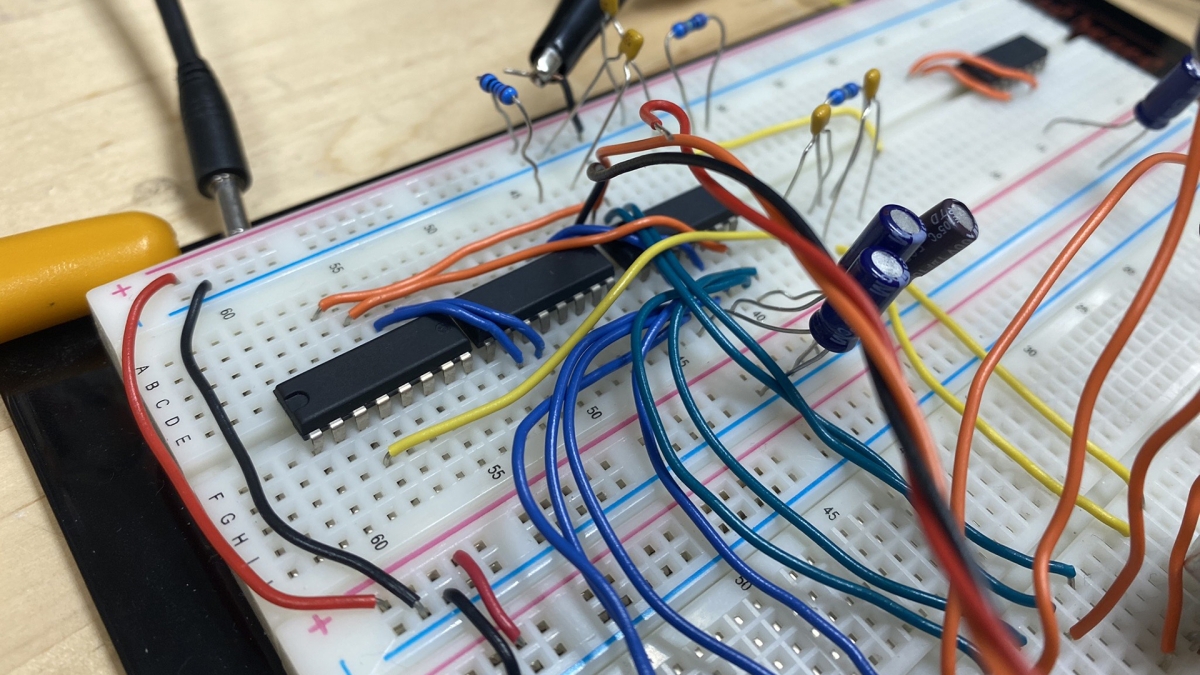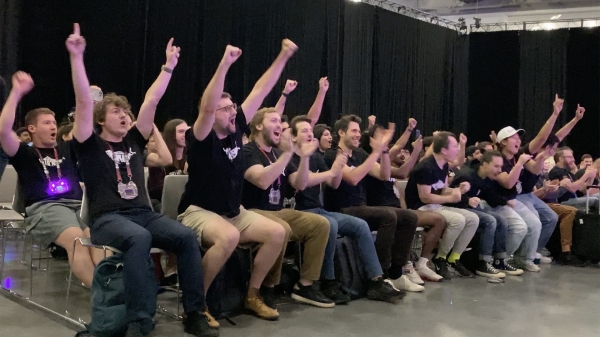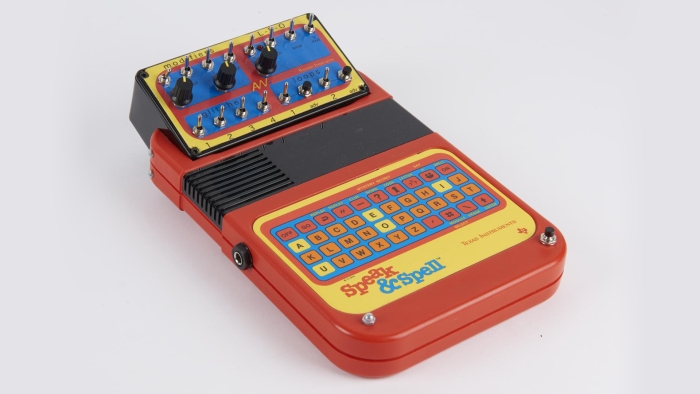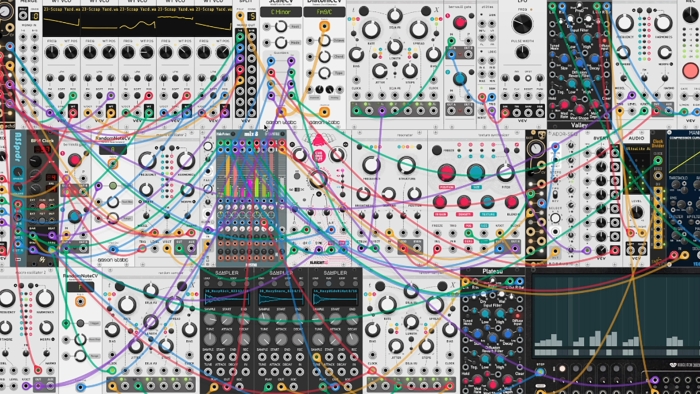Circuit bending connects computer science and creativity

The circuit bending project completed by Aivery Onstott. The computer science undergraduate student in the School of Computing and Augmented Intelligence, part of the Ira A. Fulton Schools of Engineering at Arizona State University, created a breadboard set with a multiplexer and a shift register designed to let him select different pitches to make music using circuit sounds. His goal was to surprise the listener with a chaotic sonic experience. Photo courtesy Aivery Onstott
Aivery Onstott resists the old clichés about engineers.
“Many people think engineers aren’t creative,” he says. “But really, engineering is the perfect place for creativity. The field can be a great intersection of abilities. You can use your technical skills to make art.”
The rising junior, who is studying computer science in the School of Computing and Augmented Intelligence, part of the Ira A. Fulton Schools of Engineering at Arizona State University, has found a way to turn old tech into new tunes.
He has discovered a passion for circuit bending.
Circuit boards are commonly used in electrical engineering. Typically made from a combination of fiberglass, copper and insulation, these boards connect components and allow electronic signals to flow from one part of an electrical device to another. They are an essential part of everything from smart tablets to refrigerators to power drills.
In circuit bending, these boards become highly original musical instruments. To make that happen, benders alter the boards by adding components like resistors, capacitors or buttons to cause the new device to make interesting noises or sounds. Musical artists such as Beck, REM and Men Without Hats have all included samples of circuit bending in their tracks.
Onstott found circuit bending through a class, AME 294 Topic: Circuit Bending, taught by Seth Thorn, a clinical assistant professor in ASU's School of Arts, Media and Engineering.
Bend it, break it, learn to remake it
Thorn explains that the art form has its roots in the experimentalism and do-it-yourself ethos of the 1960s. It’s a form of expression that grew from the sudden availability of inexpensive consumer electronics while serving as a critique of consumerism.
“Circuit bending is a way of extracting unexpected sounds from electronics by circumventing whatever the intentions of the original designers were,” he says. “Expressive musical instruments don’t embed strong intentions about what you’re supposed to do with them.”
Some of the earliest objects to be consistently circuit bent were children’s toys, which often create whimsical and humorous results. The 1970s Speak & Spell toy and the Furby, released in 1998, remain popular choices for enthusiasts.
Thorn’s students, such as Onstott, begin the semester with a kit that includes a breadboard — a plastic piece used for temporarily connecting circuits — as well as components like multiplexers, shift registers and switches. They get to work right away, using wiring techniques to connect circuits in the very first class.
Thorn uses a nonlinear learning model to get the budding benders working with the technology as quickly as possible. He provides theoretical instruction in tandem with the ongoing, hands-on work students do throughout the semester.
It’s a learning method that resonated with Onstott, who appreciated the encouragement to playfully misuse analog technology and believes that the process made him a better engineer.
“So, essentially, you’re breaking this equipment and, in a way, that satisfies a kind of destructive impulse,” Onstott says. “But in the process, you learn a lot about how electronic components really function.”
Onstott spent the semester creating an experimental instrument that would let him use knobs and switches to get his circuit board to play sounds in different pitches. He wanted to create a chaotic, random sound that would draw in a listener.
At the end of the semester, he demonstrated his final project at a class jam session.
“The class gives people permission to tinker and explore without being concerned about failure,” Thorn says. “Students do things by accident and get incredible results. Music taps into emotion and memory and sensory experiences. Circuit bending encourages each person to do something unique.”
Granting permission to experiment
Thorn estimates around half the of students in the class in any given year are engineering students, including computer science students, who crave a more tactile experience with the technology they use.
But his research has also shown that circuit bending can be a great way to connect all kinds of learners with STEM education.
Thorn is exploring how circuit bending might be used to help attract new students to STEM careers. Because bending provides a fun way to connect with circuits and microelectronics, Thorn often finds that it can act as a gateway to stimulating interest in electrical engineering in young people who might not have otherwise considered a technical program of study.
He has projects in development that are designed to bolster the semiconductor workforce under the CHIPS and Science Act. Arizona has been an important part of the evolution of the microelectronics industry. The state is being reborn as a hub for semiconductor manufacturing, and ASU is playing a key role in the push to boost domestic semiconductor production.
For his part, Onstott hopes to retake Thorn’s class for fun and to see if he can build something new.
“Next time, I’d like to do something a bit more controlled,” he says. “Maybe my next project will be more geared to making repeatable, musical sounds.”
Looking further out, Onstott says circuit bending will help him in his career after graduation.
He sees a future in the space where computer science and audio engineering meet, saying, “My dream job is to work somewhere doing audio programming or digital audio processing.”
More Science and technology

ASU travel behavior research center provides insights on the future of transportation
The Center for Teaching Old Models New Tricks, known as TOMNET, has spent the past seven years conducting research and developing tools to improve transportation systems planning methods and data.As…

When suspect lineups go wrong
It is one of the most famous cases of eyewitness misidentification.In 1984, Jennifer Thompson was raped at knifepoint by a man who broke into her apartment. During the assault, she tried to make a…

Jackpot! ASU hackers win $2M at Vegas AI competition
This August, a motley assortment of approximately 30,000 attendees, including some of the best cybersecurity professionals, expert programmers and officials from top government agencies packed the…

